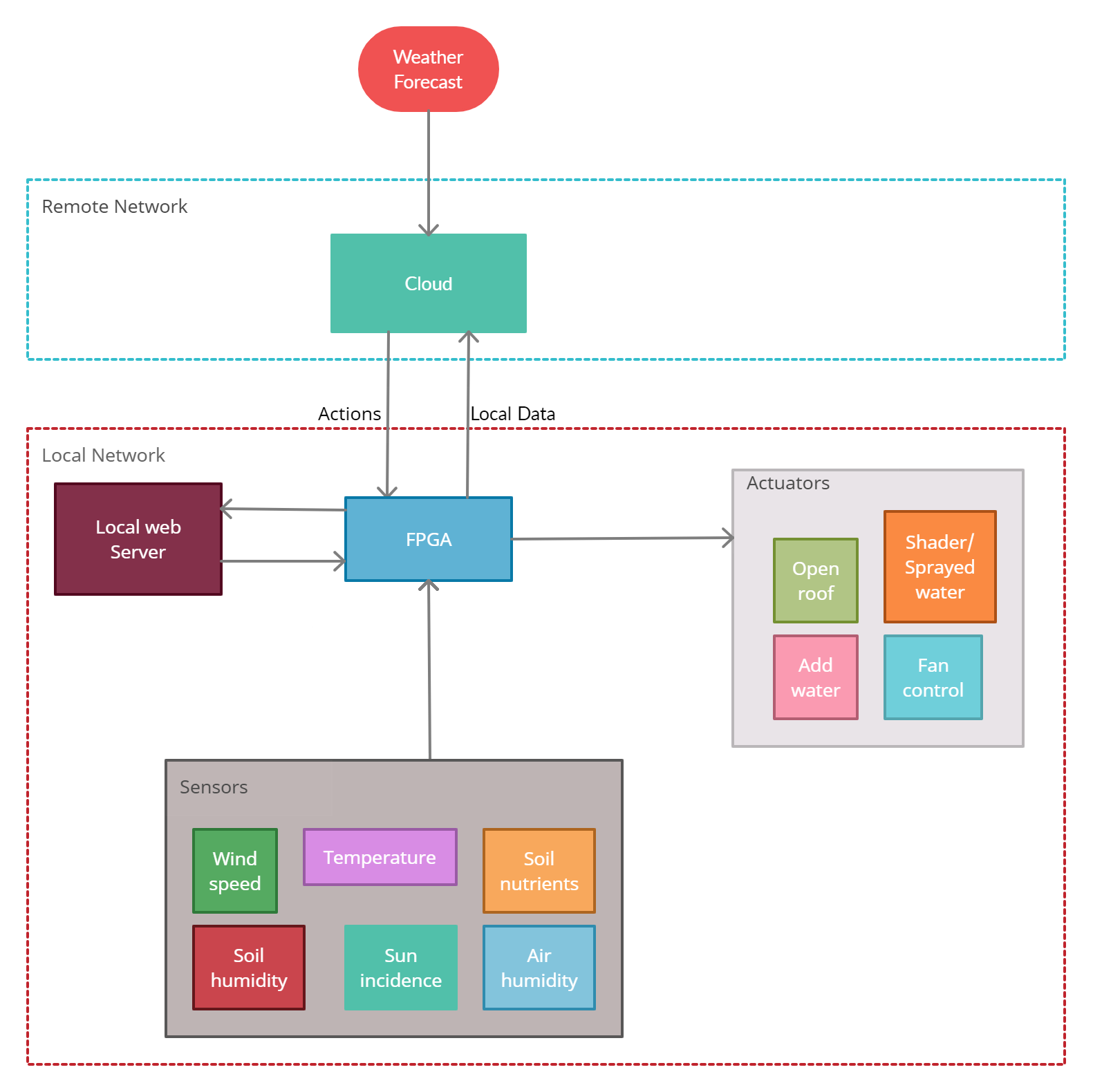Our project aims to update the current greenhouse infrastructure in order to make it more resilient against the new challenges of climate change, all keeping the cost low in order to update existing infrastructure intead of replacing it, minimising the impact on local farmers and their communities
Project Proposal
1. High-level project introduction and performance expectation
Adaptive greenhouses
High-Level Poject introduction
Global warming may be the biggest challenge humanity is facing right now. The whole planet is suffering from its consequences already, and predictions show that a big shift from current production systems is necessary if we want to maintain and improve living standards. However, most of the solutions proposed in fields like energy or transportation are based on a big change of the productive model, relying on innovative technologies not fully developed yet and lacking infrastructure.
One of the most globally affected fields is agriculture. The shift in climate patterns is making traditional agriculture insufficient and current infrastructure outdated. Up to date, most approaches to sustainable technological agriculture rely on managing environmental conditions by insulating the crop from the weather, but this approach is both expensive and ineffective, as it does not use the freely available resources from nature like rain or fresh wind, and requires new infrastructure instead of improving the already existing.
The approach of this project is to update and modernize existing farming equipment using tested and reliable technologies, in order to get a fast time-to-market for the product and low initial investment costs for the farmers who will see their farms upgraded, not replaced. We expect a big save in water and a bigger yield of the crops as the effects of pests and extreme conditions will be more easily mitigated
This device will obtain local data from sensors such as soil and air humidity, temperature, sun incidence and wind speed among others, and combine it in the cloud with public data such as weather forecasts and crop cultivation indexes, in order to generate a predictive model of the expected behavior of the crop and the field, and apply the resources and operate the infrastructure in a way that minimises the usage of water and increases production. An applied example of this is the implementation in large greenhouses where most of these variables are already managed.
One use case is tomato greenhouses. Tomatoes are a globally cultivated crop, with high water consumption and a high production rate under the right conditions, but require certain parameters to be kept between tight limits. Too much water variability and the tomatoes will break, too much sun and the plant might suffer sunburn, too little airflow and pests do not take long to appear. Implementing this project in a tomato crop will automatically manage humidity and airflow. But this is not limited to reactive measures, as we can combine current local data (like soil humidity) with weather forecasts and, for example, irrigate less and earlier the tomato plants if we expect rain, or open windows if it’s a windy day instead of wasting electricity in moving the air with huge fans.
Local sources of data include but are not limited to soil moisture and air humidity, sunlight incidence, wind speed and temperature. All data obtained via local sources is collected by the many in/out pins and sensors of our FPGA and transmitted to the cloud, where it is combined with public data obtained from the internet such as weather forecasts to generate a predictive model of the expected behaviour in the plantation. From this model we can obtain the actions necessary to be applied on the farming equipment such as opening rooftops, closing windows or watering the soil to keep the environmental conditions within the optimal limits for the crop. All of these actions are automated and transparent for the farmer, who can however check the state and override and tweak those actions via a local webapp running in an ARM Embedded Linux core in the FPGA, to which the farmer can simply connect via a smartphone or computer in the local network.
This project does not settle to react on the new challenges set by climate change, but also aims to be proactive against them, to make a stand against extreme conditions developing in up to date mild climates. All of this by making existing infrastructure resilient and helping local farmers and local communities adapt to the new environmental conditions without big investments or changing their way of life.
2. Block Diagram

3. Expected sustainability results, projected resource savings
In this project resource savings are at the focal point. Major savings are expected in water usage as freely available rain water will be used, and also there will be a more efficient watering program implemented based on weather predictions. Also, savings in electricity can be anticipated as fewer high-consumption/constant-operation machinery like industrial fans are replaced by sporadic-use mechanisms like ventilation openings. Finally, savings in pesticides and fertilizers are to be expeced as the crop will no longer be an isolated system
4. Design Introduction
5. Functional description and implementation
6. Performance metrics, performance to expectation
7. Sustainability results, resource savings achieved
8. Conclusion
0 Comments
Please login to post a comment.